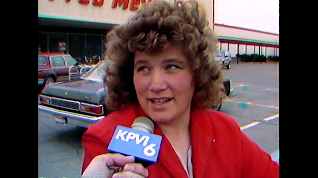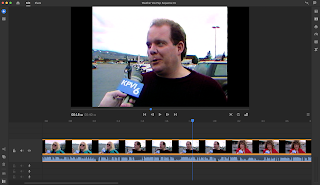How to Shoot a Vox Pop / Person-On-The-Street Interview
What is a Vox Pop?
Vox pop is a Latin term for "Voice of the People". You may hear the same concept referred to as a "Man on the Street" (MOS) or "Person on the Street" (POS). Source: https://www.voxpops.com/what-is-a-vox-pop/
The idea is to stop people on the street to ask a question. Stopping people on the street to ask for opinions is not scientific, and the results can't be used to really tell what any particular group, community, or population is thinking. However, there are many reasons to do a Vox Pop. Source:https://c60media.com/how-to-shoot-a-vox-pop
Source: In the Spirit of Thanksgiving
Reasons to Use A Vox Pop
- A Vox Pop allows for opinions from real people in connection to a legitimate study. A reporter can ask people's views about the survey or study results.
- A Vox Pop can help get a feel for people's thoughts about a specific event or issue. The journalist needs to clarify that this is just a sampling of people willing to go on camera.
- A Vox Pop can be used as more of a feature story. A reporter can ask questions about pop culture, such as, "What do you think about the Academy Awards?" or "What do you think about the latest Star Wars movie?".
 |
| Vox Pop Interview from the 1990s |
As a TV Journalist in the 90s, I was occasionally asked to do a "Vox Pop" as a filler piece when our newscast was short on time. We would head to the local supermarket and stop shoppers as they exited. Stopping shoppers at 2p.m. on a weekday as they left a supermarket has some journalistic issues right upfront.
First, I really didn't like asking shoppers mundane questions like, "What do you think of the rainy weather this week?". Beyond that, there is a limited demographic that you will encounter in the middle of the afternoon at the supermarket.
Vox Pop Interview at Grocery Store
Here are a few fundamental guidelines to make sure your Vox Pop is a legitimate journalistic endeavor.
Vox Pop Guidelines
- Location. Where you shoot will determine the possible demographics of respondents. Stopping people as they exit a polling place will give you a much better chance of getting quality respondents about the local/national election. Choose a location that works to find people who will be able to respond intelligently to your question.
- Question: A yes-or-no question is fine as a gatekeeper question. Beyond that, your question needs to be carefully crafted so it can be quickly answered in 10-20 seconds. Vox Pops are not designed as depth-interviews. They are intended for short, pithy comments. If you want to get a feel for how students feel about parking at the local campus, it is a good idea to ask a gatekeeper question like, "Do you drive a car to class?". If they do, you can ask an open-ended question like, "What is your take on parking on campus?" Don't ask a leading question like, "What do you think of the horrible parking on campus?".
- Equipment: This is a one-person-band project. You'll run the camera, stop the people, and ask the questions. Simplify as much as possible. I suggest using a smartphone with a shotgun-style mic. This way, you won't have to attach a lavalier and hide the cable. It will also be quicker. (See post on smartphone video accessories)
Vox Pop Step-by-Step
Now that you know what a Vox Pop is, it is time to make it happen. Here is a step-by-step guideline to get you going.
- Pick a relevant question and try it out with people who will give you honest feedback. Make sure it is an open-ended question.
- Pick the location where you will find people. As mentioned above, ensure you can reach the right demographic at your chosen site. Also, make sure the location has reasonable lighting and doesn't have excessive background noise (cars, people, ventilation, etc.).
- Ensure your equipment is ready (charged battery, correct cables, tripod, etc.). There is nothing worse than getting to the location and not having the right equipment . . . like a microphone.
- Use a tripod! There are times to go handheld, but most of the time, a tripod is better.
- Review all of the guidelines for interviewing. Eyeline, rule of thirds, lead room, headroom, etc. all apply. Remember that you will probably interview people of different heights, adjust your tripod accordingly.

Vox Pop Interview at Southern Utah Univ. - Give your interview participants specific instructions. Tell them what the interview will be used for, where it will appear, and why you are doing it. Remind them to look at you and not at the camera.
- Ask the person interviewed to say and spell their name while the camera is recording. You'll want to use their name for a lower-third, and you'll want to spell it right.
- Ask your question! Ask each person the same question or questions.
- Monitor the audio. Use headphones if at all possible. The microphone hears different things than you do. Check your audio meters as well. Make sure the average levels are around -10db and aren't pegged in the red.
- Review the interview before you let the interview participant walk away. It is better to re-ask a question if the framing or audio had issues than not have enough interviews or redo the project because there were audio/video issues, and you didn't check.
- Thank the people you interview. Leave them with a good impression.
- Gather up your gear and double-check before you walk away. It is a hollow feeling when you realize you've left your microphone someplace.
 |
| Adobe Rush for Editing Vox Pop |
Editing:
- Review all of your interviews. It is always a good idea to do a few more interviews than you think you will need so you can be picky. Decide the order of your interview clips for maximum impact.
- Create a graphic with your question to open the Vox Pop. Make sure the graphic is up long enough so it is easy to read for the average person's reading rate.
- Place your interview clips in the timeline. The interview clips should be around ten and typically at most 20 seconds.
- Fine-tune your edits. Use video cuts, but add audio cross-fades to help smooth out the Vox Pop. Make sure there are no long pauses or up-cuts. An up-cut is when part of a word is cut at the beginning or end of the interview sound bite.
- Watch the finished video from beginning to end. Adjust the audio levels so they are all even. Look for any flaws in the edit.
- Background music is optional. If you choose background music, make sure:
- You have the rights to use the music.
- The music fits with the mood of the Vox Pop.
- The music doesn't interfere or compete with the interview audio.
- Don't use music with lyrics. Lyrics compete too much with sound bites.
Example of Vox Pop with Flaws
Vox Pop With Flaws


Comments
Post a Comment